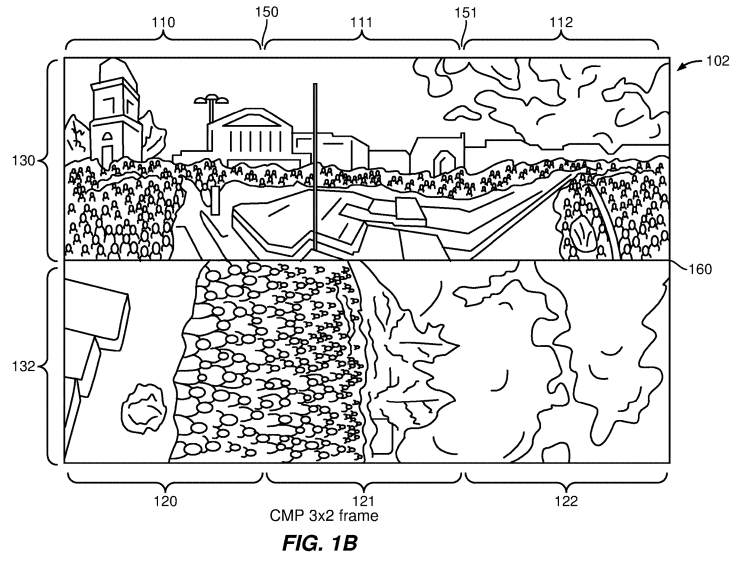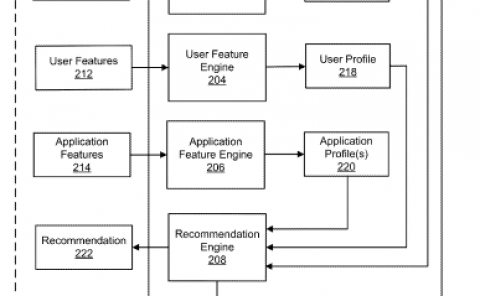Qualcomm Patent | Reducing Seam Artifacts in 360-Degree Video
Patent: Reducing Seam Artifacts in 360-Degree Video
Publication Number: 20190005683
Publication Date: 2019-01-03
Applicants: Qualcomm

Abstract
Provided are systems and methods for processing 360-degree video data by obtaining a 360-degree rectangular formatted projected picture, where the 360-degree rectangular formatted projected picture includes at least a first region, the at least first region includes at least one region boundary, and the at least first region includes a first region area; determining at least one guard band area located within the first region area, where the at least one guard band area is located alongside the at least one region boundary, and the first region area further includes a projected region area located outside the at least one guard band area; and coding a current coding block in the at least one guard band area using at least one additional guard band sample.
Background
Video coding standards include Joint Video Exploration Team (JVET) of MPEG and VCEG, ITU-T H.261, ISO/IEC MPEG-1 Visual, ITU-T H.262 or ISO/IEC MPEG-2 Visual, ITU-T H.263, ISO/IEC MPEG-4 Visual, ITU-T H.264 (also known as ISO/IEC MPEG-4 AVC), including its Scalable Video Coding (SVC) and Multiview Video Coding (MVC) extensions and ITU-T H.265 (also known as ISO/IEC MPEG-4 HEVC) with its extensions.
Summary
In various implementations, methods, devices, apparatus, and computer-readable media for processing 360-degree video data to obtain better coding efficiency are described herein.
A method can include obtaining a 360-degree rectangular formatted projected picture, where the 360-degree rectangular formatted projected picture includes at least a first region, the at least first region includes at least one region boundary, and the at least first region includes a first region area; determining at least one guard band area located within the first region area, where the at least one guard band area is located alongside the at least one region boundary, and the first region area further includes a projected region area located outside the at least one guard band area; and coding a current coding block in the at least one guard band area using at least one additional guard band seam artifact reducing sample.
In some embodiments, the method can include identifying the at least one additional guard band seam artifact reducing sample located within the current coding block.
In further embodiments, the coding the current coding block in the at least one guard band area using the at least one additional guard band seam artifact reducing sample can include: performing a gradient operation that transitions from the at least first region to a second region using the at least one additional guard band seam artifact reducing sample.
In additional embodiments, the coding the current coding block in the at least one guard band area using the at least one additional guard band seam artifact reducing sample can include: performing blending operations using the at least one additional guard band seam artifact reducing sample.
In some implementations, the 360-degree rectangular formatted projected picture can include a second region, and identifying the at least one additional guard band seam artifact reducing sample located within the current coding block can include determining that the at least one additional guard band seam artifact reducing sample is located in the second region.
In further implementations, the guard band seam artifact reducing sample is identified as located in a non-guard band area.
In additional implementations, the 360-degree rectangular formatted projected picture further comprises a second region, wherein the guard band seam artifact reducing sample is a gradient sample that transitions between the first region to the second region.
In some embodiments, determining that the at least one additional guard band seam artifact reducing sample is located in the second region is performed using 3D-to-2D geometric mapping.
In further embodiments, the 3D-to-2D geometric mapping is one of: a cubemap (CMP) process, an adjusted cubemap (ACP) process, and an equatorial cylindrical (ECP) process.
In additional embodiments, the method can include applying interpolation filters across both the current coding block and the at least one additional guard band seam artifact reducing sample.
In some implementations, performing motion estimation using the at least one additional guard band seam artifact reducing sample.
In further implementations, the at least one additional guard band seam artifact reducing sample is a duplicate sample from the projected region area.
In additional implementations, the first region area can include at least one coding tree unit (CTU), where the CTU includes at least one CTU boundary, and the at least one CTU boundary is located along the at least one region boundary.
A device can include a memory and a processor configured to perform a method that includes obtaining a 360-degree rectangular formatted projected picture, where the 360-degree rectangular formatted projected picture includes at least a first region, the at least first region includes at least one region boundary, and the at least first region includes a first region area; determining at least one guard band area located within the first region area, where the at least one guard band area is located alongside the at least one region boundary, and the first region area further includes a projected region area located outside the at least one guard band area; and coding a current coding block in the at least one guard band area using at least one additional guard band seam artifact reducing sample.
A computer-readable medium can be a non-transitory computer-readable medium that obtains a 360-degree rectangular formatted projected picture, where the 360-degree rectangular formatted projected picture includes at least a first region, the at least first region includes at least one region boundary, and the at least first region includes a first region area; determines at least one guard band area located within the first region area, where the at least one guard band area is located alongside the at least one region boundary, and the first region area further includes a projected region area located outside the at least one guard band area; and codes a current coding block in the at least one guard band area using at least one additional guard band seam artifact reducing sample.
An apparatus can include means for obtaining a 360-degree rectangular formatted projected picture, where the 360-degree rectangular formatted projected picture includes at least a first region, the at least first region includes at least one region boundary, and the at least first region includes a first region area; determining at least one guard band area located within the first region area, where the at least one guard band area is located alongside the at least one region boundary, and the first region area further includes a projected region area located outside the at least one guard band area; and coding a current coding block in the at least one guard band area using at least one additional guard band seam artifact reducing sample.



